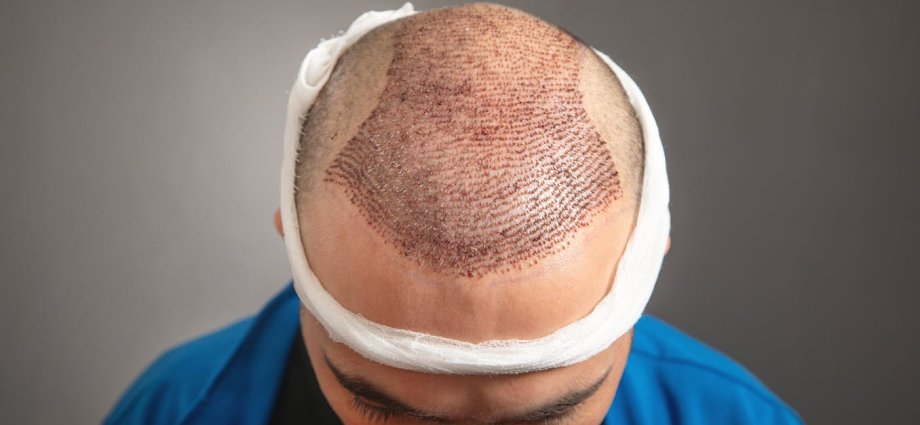Hair loss will affect everyone at some point in their life. But, despite its prevalence, treating baldness is big business.
In Europe, for example, there was a 240% increase in interest in hair transplant surgeries between 2010 and 2021 and Turkey has become such a popular destination for hair transplant surgery that some staff have renamed Turkey Airlines as “Turkey Hairlines”.
Hair loss is a normal process. Humans typically lose 50-100 hairs a day – which are replenished – but like other bodily processes as we age, hair growth slows down.
The sebaceous glands producing the oil that makes our hair shiny reduce their activity, which makes hair look duller. Some hair follicles will reduce their productivity, making hairs thinner and some may stop altogether, which results in fewer hairs.
Thinning hair and baldness, however, are still stigmatised and increasing numbers of people are opting for hair restoration treatments.
A hair transplant is classed as a cosmetic procedure and isn’t covered under NHS care in the UK. The cost can prove prohibitive for some people who choose to travel to other countries where the procedure can be much cheaper.
While there are many positive reports of people who’ve had hair transplants abroad, there are cases where the surgery has been carried out by an unqualified person and where people unsuitable for hair transplants have still been treated.
Hair transplants should always be carried out by a qualified surgeon – and not everyone is eligible or suitable for hair transplantation.
The most suitable candidates are those with androgenic alopecia – originally termed “male pattern baldness” but it affects both sexes. Around 10% of women under 40 have some evidence of hair loss, rising to more than 50% by 70 years. In contrast, 30-50% of men by age 50 have hair loss associated with androgenic alopecia.
Men usually develop a receding hairline in an “m-shape” known as the Norwood pattern, whereas women tend to develop a wider parting and hair thinning at the crown and at the front of the scalp. This is known as the Ludwig pattern.
Treatment options
Initial treatment for hair loss is usually is medicinal. Finasteride, a medicine which treats benign prostate enlargement and hair loss in men, takes three to six months to show any results. However, any benefits are lost within six to 12 months of stopping treatment. Minoxidil, another drug to treat androgenic alopecia, has been shown to have benefits for hair loss. But laser light therapy, administered using a special cap, has demonstrated mixed results.
If initial treatments prove unsuccessful, patients may opt for hair transplants. Two techniques are most commonly used: follicular unit transplantation (FUT) – also known as follicular unit strip surgery (FUSS) – and follicular unit excision (FUE).
Both procedures require the availability of viable hair, usually from other areas of the scalp – typically the hairs that run from the temple on either side and around the back of the head.
Using the FUT technique, the surgeon removes a 1-1.5cm wide strip of skin from the back of the scalp. The hairs their supporting structures are harvested from this strip and inserted into the balding area. The wound where the skin was removed is stitched back together. Usually, the surgeon is careful to avoid noticeable scarring.
However, FUE is the more common procedure thanks to its shorter healing time, lower risk of scarring and increased number of harvestable hair grafts. Sometimes this procedure is marketed as “blade free” and “scarless” – this is not the case. The follicles are harvested and implanted using sharp blades and scarring has been reported, including hyper- or hypopigmented as well as raised or keloid scars.
Hair raising?
Long-term success of hair transplantation is variable. Studies report that 90% of recipients have good coverage a year after surgery – but that drops to 9% after four years. Many factors can affect the results of hair transplants, including age, smoking, sun-damage to scalp and diabetes. Following the recovery guidance is essential and although some clinics advertise “painless” hair transplants, the recovery is often inconvenient and uncomfortable.
Anaesthetic may be used during the procedure but the scalp can be swollen and tender afterwards and there’s significant downtime. Patients are advised to take a fortnight off work and avoid strenuous physical activity while the grafts are fragile and insecure. It can take ten to 18 months to see the full results of the transplant.
Hair transplants may be a popular option for those worried about hair loss but it’s a big decision and not one to be taken lightly. If you’re thinking of undergoing the procedure, do your research to ensure you’ll be treated by a fully qualified surgeon – and be prepared to follow recovery guidelines to the letter to ensure best results.
![]()
Adam Taylor does not work for, consult, own shares in or receive funding from any company or organisation that would benefit from this article, and has disclosed no relevant affiliations beyond their academic appointment.











